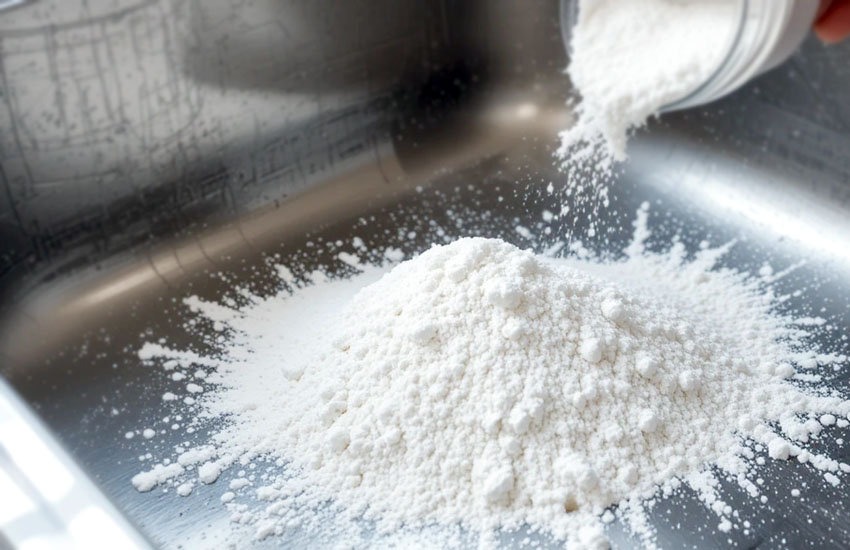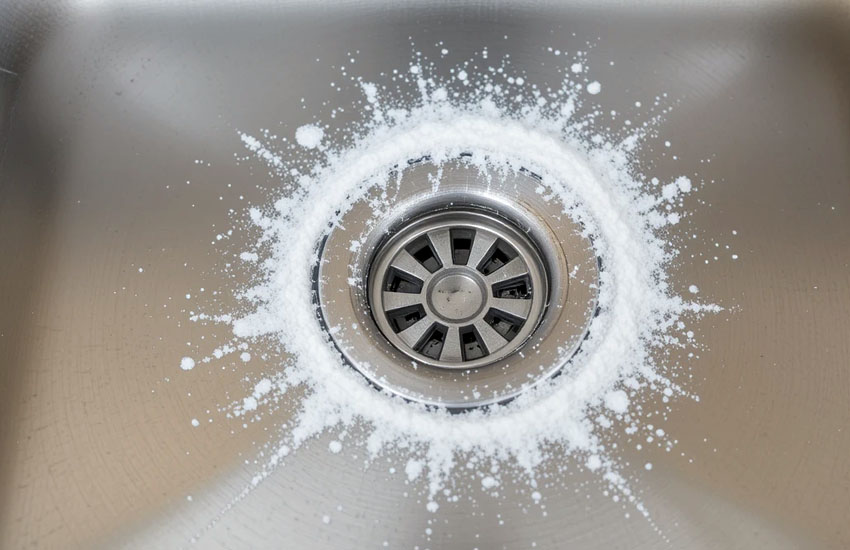If you’re tired of that funky smell coming from your sink drain or dealing with slow drainage, you’re not alone! But don’t worry, you don’t need fancy chemicals or professional help to fix it. You can clear up clogs and freshen up your drain with two simple, natural ingredients that you probably already have in your kitchen: baking soda and vinegar. In this fun and easy guide, I’ll walk you through some super-effective methods for cleaning your sink drain with these two powerhouse ingredients. Grab a cup of coffee, and let’s get started with these simple DIY tips!

Method 1: The Classic Baking Soda and Vinegar Drain Clean
If you’re looking for a quick fix, the baking soda and vinegar method is your best friend. This is probably the most popular method for cleaning a sink drain, and it’s no wonder why. Not only is it simple, but it’s also super effective in getting rid of odors, grease, and even minor clogs.
Step 1: Prep Your Sink Drain
Before you begin, remove any debris from your drain. You know, those food scraps and hair strands that love to sneak in there! Once the area around the drain is clean, you’re ready to go. It’s important to start with a dry drain, so make sure there’s no standing water. If there is, try to remove it with a cup or small container.
Step 2: Pour Baking Soda into the Drain
Take about half a cup of baking soda and pour it directly into the drain. Make sure to get it as deep into the drain as possible. Baking soda will help loosen any grime, grease, or food particles stuck to the sides of the drain.
Step 3: Add Vinegar to the Mix
Now, grab your trusty vinegar (white vinegar works best!) and pour about one cup down the drain right after the baking soda. You’ll start to hear some fizzing action. This reaction between baking soda and vinegar is what helps break down the buildup in your drain, making it easier to flush away.
Step 4: Wait for the Magic to Happen
Let the mixture sit for 10-15 minutes to give it time to work its magic. You’ll hear the fizzing slow down, which means the cleaning action is happening! If you’re feeling patient, you can even leave it for 30 minutes for an extra deep clean.
Step 5: Flush with Hot Water
After waiting, it’s time to rinse everything away. Boil a kettle of water or use the hottest tap water you can get, and pour it down the drain. This helps wash away any remaining debris, leaving your drain sparkling and fresh.
Step 6: Check the Results
After you’ve flushed everything out, check your drain. Does the water flow more freely? Does the smell go away? If the drain is still a little sluggish, repeat the process, or you may need to try a more intense method.
This method is great for regular maintenance, but if you have a more serious clog, you may need to go a step further.
Method 2: The Deep-Cleaning Drain Detox with Baking Soda and Vinegar
For those times when your sink is really backed up or has a persistent bad smell, you’ll want to do a more thorough cleaning. This method uses a longer soak with baking soda and vinegar to break up tougher clogs and sanitize the drain completely.
Step 1: Remove Standing Water
Start by removing any standing water from the sink. If there’s a lot of water in the sink, try using a cup or small container to scoop it out. You want to make sure your drain is dry so that the baking soda and vinegar can work their best.
Step 2: Pour in the Baking Soda
For this method, you’ll need more baking soda than in the previous method. Use about 1/2 to 3/4 cup of baking soda. Pour it directly into the drain, making sure to cover the entire drain area. You want to allow the baking soda to penetrate as much of the drain as possible to loosen up any build-up and grease that might be causing clogs.
Step 3: Add the Vinegar
Next, pour 1-2 cups of white vinegar into the drain. The vinegar will react with the baking soda, creating a fizzing and bubbling action. This is completely normal and is what helps dislodge stubborn grease, grime, and other debris from your pipes. You may want to plug the drain with a rag or stopper to keep the bubbling mixture contained.
Step 4: Cover and Wait
Now that you’ve added both ingredients, cover the drain with a rag or a sink plug. This helps trap the fizzing action inside the drain, which allows the baking soda and vinegar to work longer and harder. Let this mixture sit for at least 30 minutes, but if you can, try to leave it for an hour or more.
Step 5: Rinse with Hot Water
Once you’ve let it sit, it’s time to rinse everything away. Boil a kettle of hot water and pour it down the drain slowly. The hot water helps dissolve the baking soda and vinegar residue, as well as flush away the loosened gunk.
Step 6: Repeat If Necessary
Sometimes, really stubborn clogs or smells require a second round. If after flushing, the drain is still slow or stinky, feel free to repeat the process. However, if after two attempts the clog hasn’t budged, it might be time to get a plunger or consider calling in a plumber.
This deep-clean method is great for regular maintenance or tackling bigger issues like grease build-up. Doing this once a month can help prevent blockages and keep your drains fresh and odor-free.
Method 3: Baking Soda and Vinegar + Salt for Extra Scrub Power
If you’re looking for a more powerful clean and want to add a bit more scrubbing power to the mix, combining salt with baking soda and vinegar will work wonders. Salt is a natural abrasive, so it helps break down more stubborn grime while the baking soda and vinegar work to clean and deodorize your drain.
Step 1: Remove Any Water
As always, start by removing any standing water from the sink. You want to make sure the drain is as dry as possible for the best results.
Step 2: Add Baking Soda and Salt
Take about 1/2 cup of baking soda and mix it with 1/4 cup of salt. Pour the mixture into the drain and make sure it’s spread out evenly. Salt will act as a gentle abrasive that scrubs away any stubborn gunk stuck in your pipes while the baking soda breaks it down.
Step 3: Pour in Vinegar
After adding the baking soda and salt mixture, pour in 1 cup of white vinegar. You’ll hear the familiar fizzing sound as the vinegar reacts with the baking soda. This is what you want—it means the ingredients are working to break down grease, grime, and debris.
Step 4: Plug the Drain and Wait
Cover the drain with a stopper and let the mixture sit for at least 30 minutes, preferably an hour if you can. The salt, vinegar, and baking soda combination will help clean even the most stubborn areas in your pipes.
Step 5: Rinse with Hot Water
After letting the mixture work its magic, slowly pour hot water down the drain to flush everything out. The water helps clear away the salt and residue, leaving your drain cleaner and smelling fresh.
Step 6: Check the Results
Once you’ve rinsed everything down, check how your drain is performing. Is the water flowing smoothly again? If you’re still experiencing issues, a plunger or more advanced cleaning tools might be necessary, but this combo should handle most problems.
This method works especially well for tough grease clogs and when you want a deep clean.
I hope this guide helps you say goodbye to clogged, smelly drains for good! Using baking soda and vinegar is a simple, effective, and natural way to keep your sink drain clean and fresh without the need for harsh chemicals. Whether you’re dealing with a minor clog or just want to keep things running smoothly, these methods will get the job done. So, next time you notice a bit of slow drainage or that familiar sink smell, grab your baking soda and vinegar and give these methods a try!

Frequently Asked Questions
Is it safe to use baking soda and vinegar to clean drains?
Yes! Baking soda and vinegar are both natural ingredients that are safe for most drains. They won’t damage your pipes or the environment.
Can baking soda and vinegar fix a completely clogged drain?
While baking soda and vinegar are great for light clogs and regular maintenance, a completely clogged drain may require a plunger or a plumber.
Do I need to use hot water after the baking soda and vinegar mixture?
Yes, hot water helps rinse away the mixture and any loosened debris. It also helps clear your pipes, ensuring everything flows smoothly.
Is it effective to use baking soda and vinegar to prevent bad smells in the drain?
Absolutely! The combination of baking soda and vinegar works great for neutralizing bad odors, keeping your drain smelling fresh.
Can I use this method for bathroom drains?
Yes, this method works well for bathroom drains, including sink drains, shower drains, and even bathtub drains.
Is there any other way to clean drains without using chemicals?
Yes! You can use natural ingredients like lemon juice, salt, and even baking soda alone to clean drains. However, baking soda and vinegar is the most popular and effective method.
Do I need to use a drain snake after using baking soda and vinegar?
If you still experience a slow drain after using baking soda and vinegar, you may need a drain snake to physically remove any tough blockages.
Can I use this method on kitchen sink drains with grease build-up?
Yes, the baking soda and vinegar method is particularly effective at breaking down grease and food debris, making it ideal for kitchen sinks.

